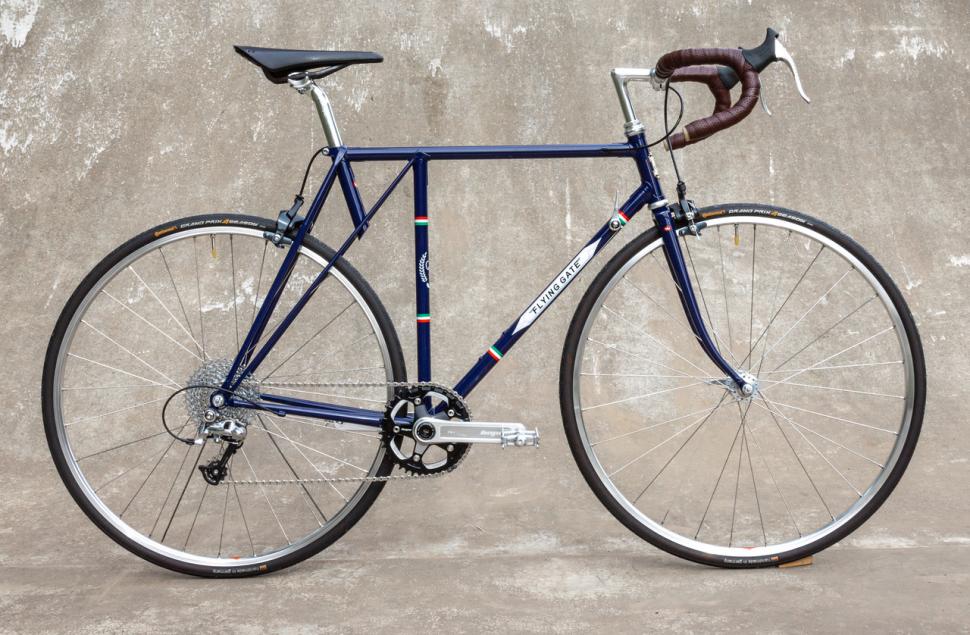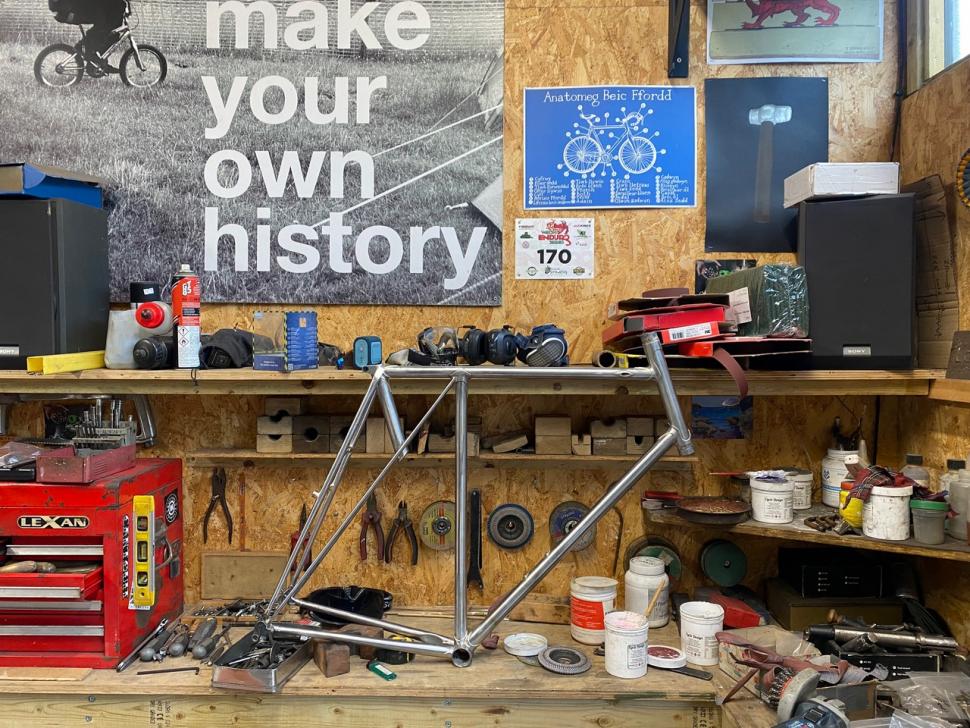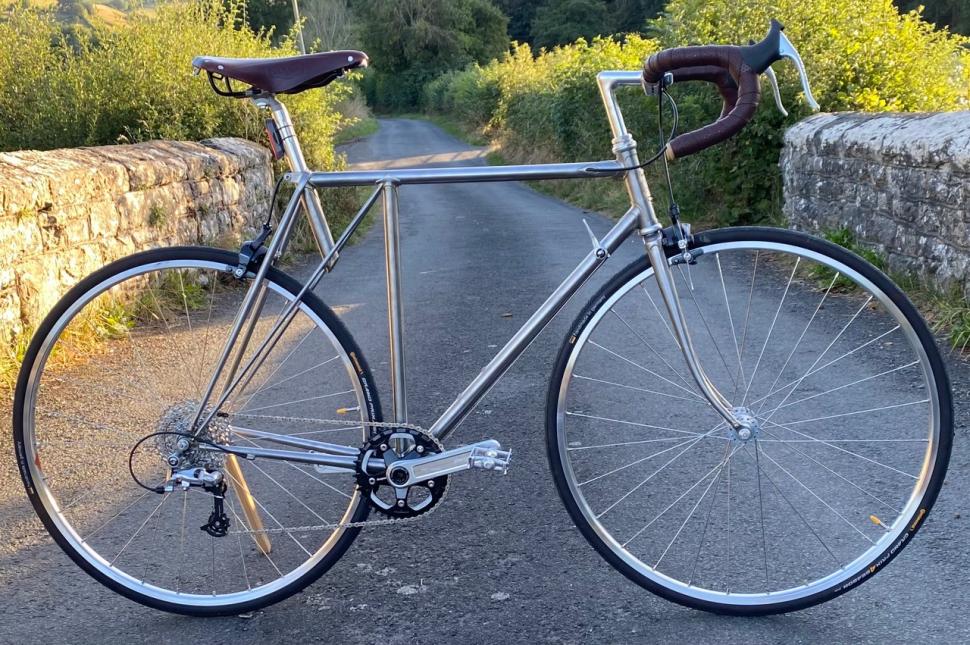- News
- Reviews
- Bikes
- Components
- Bar tape & grips
- Bottom brackets
- Brake & gear cables
- Brake & STI levers
- Brake pads & spares
- Brakes
- Cassettes & freewheels
- Chains
- Chainsets & chainrings
- Derailleurs - front
- Derailleurs - rear
- Forks
- Gear levers & shifters
- Groupsets
- Handlebars & extensions
- Headsets
- Hubs
- Inner tubes
- Pedals
- Quick releases & skewers
- Saddles
- Seatposts
- Stems
- Wheels
- Tyres
- Tubeless valves
- Accessories
- Accessories - misc
- Computer mounts
- Bags
- Bar ends
- Bike bags & cases
- Bottle cages
- Bottles
- Cameras
- Car racks
- Child seats
- Computers
- Glasses
- GPS units
- Helmets
- Lights - front
- Lights - rear
- Lights - sets
- Locks
- Mirrors
- Mudguards
- Racks
- Pumps & CO2 inflators
- Puncture kits
- Reflectives
- Smart watches
- Stands and racks
- Trailers
- Clothing
- Health, fitness and nutrition
- Tools and workshop
- Miscellaneous
- Buyers Guides
- Features
- Forum
- Recommends
- Podcast
feature
 flying-gate-41
flying-gate-41The iconic Flying Gate bike just keeps flying... and now it even takes wide tyres
The Flying Gate, a legendary British bike frame, has been around for nearly 90 years, and the rather unusual design is still being manufactured, just by a different frame builder. It now even comes in a "rough stuff" design allowing for up to 32mm tyres.
Originally made by the Baines Brothers who entered the bike-making business in the late 1800s, the iconic short-wheelbase Flying Gate has been around for generations.
> 10 of the best 20th century bike builders from the North and Midlands
The bike was originally a product of Baines Brothers, and over the years the design became something of a legend. There were talks about it being used by the 1938 Olympic cycling team until the war put a stop to the Games. And when Baines had to shut up shop in the 1950s, the manufacturing of Flying Gate was on hiatus for a couple of decades.
That was until 1979, when Trevor Jarvis of TJ Cycles picked up the business and started making the bike again. Trevor re-registered the design under the name Flying Gate, an old bike nickname that references the quirky lines and fast ride.
The design
Before looking at the newer developments, let's first go back to the origins. The Flying Gate was originally designed by Reginald Baines of the Baines Brothers in 1934, then called the ‘VS37’. The VS in the name stands for ‘very short’ and really, the 940mm wheelbase of this bike was and is, really short. Later, it also came to be known as Whirlwind and International TT.
The bike shone on the roads with riders such as Jack Fancourt, Jack Holmes and many others recording excellent times on this new responsive design and the name "Gate" came later, derived from its unusual construction. This nickname stuck, however, and this is what we call it today.
> 10 of the best British bike brands of the ‘70s and ‘80s
The basis of the Flying Gate's unusual-looking design was short chainstays, which radically reduced the overall wheelbase. The traditional seat tube was cut off and a new vertical tube was fitted from the bottom bracket, perpendicular to the standard-length top tube.
This made the bike ideal for time trials, as the rider could maintain an optimal ‘tucked’ riding position but with greater acceleration, as the rear wheel sits very close to the bottom bracket. Where the vertical tube meets the top tube (known as the T-lug), small diameter strut tubes were added to join directly with the rear dropouts, giving a secure fixing point for the short seat tube as well as contributing to the desired responsiveness, which remains true to this day.
The vertical tube that really makes the bike stand out from the crowd adds stability to the head tube too, but without making the ride feel ‘harsh’. Jarvis says: "The vertical tube adds triangulation that counters the torsional pedalling forces, producing a bicycle that has given great pleasure to all those who have ridden one."
From TJ Cycles to Smithy Frameworks
Trevor Jarvis continued to make several different designs of the Flying Gate, and many of the 600 frames he made became collector's items (there is a whole facebook group dedicated to Flying Gate enthusiasts). Jarvis had already planned to retire at the age of 80 and hired Liz Colebrook to make the frames for him.
But years after, he was still going; and when Colebrook wanted to move on to do other things, Jarvis was looking for someone to take over. In 2021 Jarvis met Chris Yeomans, an avid cyclist, artist and blacksmith-turned bespoke bike frame builder. With 29 years experience of manipulating metal in his bike frame building, Yeomans was up to the challenge.
“The tipping point for me was when we went along to the Flying Gate Weekend, an annual meeting of Flying Gate enthusiasts that attracts over 50 riders for a weekend of riding and food. Lots of food!", Yeomans recalls.
"Ages range from 17 to 87 for the riders, with frames dating from the 1940s to the day before the weekend. I was blown away by the enthusiasm they had for the bike and their sense of community. I realised it was an opportunity that if overlooked I could well regret for a long time."
In 2021 Yeomans took over the ownership of TJ Cycles but continued to liaise with Jarvis on all things Flying Gate.
Along with the business came the frame jig that Jarvis had built in the 70s. Moving it out of his workshop for the first time in 40-odd years was a big step for someone who has dedicated so much of his life to building this frame.
To this date, the design of the frame remains pretty much the same as the original Baines, Yeomans says.
"Jarvis used to alter the lug designs every so often and I will do the same. Dropouts are now available in stainless and the tubes available to the Baines brothers have been superseded by better ones from Reynolds and Columbus."
Yeomans has introduced the Flying Gate RS (rough stuff) model which will take 32 mm tyres, as big as you can go without drastically changing the design. This was in response to tyres volumes that Jarvis had never dreamt of using, Yeomans says.
"28mm was considered the max. It’s not a gravel bike, more a respectful nod to the Rough Stuff riders of yesterday. What we try to do on a bike hasn’t changed much over the years, it’s just that nowadays there is more chance of the bike coming home in one piece. Oh and less pushing!" Yeomans explains.
And what about Trevor Jarvis?
“He [Trevor] informed me last week that he has finally handed his gas bottles back and is officially retired at 88. We’ll wait and see,” Yeomans laughs.
You can find out more about the Flying Gate on the TJ Cycles website and about Chris Yeomans from Smithy Frameworks.
Latest Comments
- rookybiker 46 min 35 sec ago
The trailer seems to connect to both ends of the rear axle. Can it do tight corners without dragging the tyre sideways?
- mattsccm 46 min 42 sec ago
Surely the answer is to ban urban traffic. This cobblers about wide vehicles squeezing down between two sets of parked cars would be easy to solve...
- froze 49 min 55 sec ago
Motorists have always been unkind to cyclists, but distracted driving is adding to the problem....
- Destroyer666 1 hour 43 min ago
Have you owned Bont shoes? In my experience even the widest Lake shoes have had a bizarre form of narrowing way too much in the toe area. But the...
- froze 2 hours 10 min ago
Not sure if this is possible, but this news letter goes out all over the world, and some places like Decathlon does not send stuff to America, in...
- Hirsute 2 hours 55 min ago
I'm confused as to why you'd need bib shorts indoors.
- Oldfatgit 3 hours 24 min ago
I'm sure you were being sarcastic... however ... Lewis Hamilton lives in Monaco. Yet another car driver that doesn't pay any tax
- BikingBud 5 hours 36 min ago
Paddington Harrow Road crash leaves two seriously injured...
- TheBillder 9 hours 2 min ago
I've had (past tense is deliberate) 3 of these over the past 5 years. I'm back here researching for a replacement as my last one broke last week. I...





Add new comment
24 comments
No published price list.
That sounds .. er .. interesting.
"This made the bike ideal for time trials, as the rider could maintain an optimal ‘tucked’ riding position but with greater acceleration..."
I would love an explanation, using physics or biomechanical principles, of how this works in any meaningful way, other than if the design somehow allows a lighter bike. Is it the pedal-saddle relationship?
I can explain it, like so many claims (X number of watts faster, X % stiffer/more compliant etc), it is BS (you probably don't need me expand the abbreviation for you but as a clue it has a strange aroma). Marketing over science again
I seem to remember reading ages ago (possibly in Richard's Bicycle Book), that way back then in cycle racing the amateur rules forbade any manufacturer names on the frame. So frame manufacturers were forced to make their frames highly individual and recognisable if they were to get any return for their efforts.
Also the explanation I've heard for the Hetchins curly stays.
I had a bike shop owner say something similar a few years ago regarding one bike with longer chainstays than another.
When I (politely) asked how chainstay length contributed to acceleration he relented and said it contributed to the 'feeling' of acceleration, which I could understand as the wheel is further underneath you so you would probably 'feel' the bike trying to accelerate out from under you more than a longer bike.
There are two ways I can think of that shorter chainstays could be genuinely advantageous: firstly the shorter the chainstay is the less it will flex, so improving power transfer, and secondly the closer the rear wheel is to the centre of gravity (or your arse, to put it crudely) the more downforce there will be on the tyre's contact patch so again, more efficient power transfer.
Really? Where are the power losses coming from by moving the contact point a bit further away from your centre of gravity? Unless your wheel starts spinning you will still put the same power down through the contact point. A longer chain and longer chain stays might rob some power but unless you can explain to me how simply moving the contact point with all other things being the same reduces power transfer I have to disagree with you on this point.
No you won't, if you have more weight over the contact patch you will have more traction, better traction equals more efficient power transfer. Just because you can't feel the wheel spinning out doesn't mean it's gripping as well and transferring power as well. Think of an F1 car, the drivers are always faster on new tyres and slow as they get older. Why is that, the engine's putting out the same power, it's because the tyres have less traction.
Cars are faster on new tyres because they offer better grip so they don't wheel spin as much and they can corner faster. That increased traction comes from tyre condition and nothing to do with the relative position on contact point relative to centre of gravity. If contact point was a factor don't you think that at least one F1 car in the history of racing would have tried variable wheel base chassis?
Now then, you're being disingenuous: you know I wasn't using the F1 example related to weight over the tyre, simply an example of how better traction leads to more efficient power transmission. If you have more weight over the contact patch, you will get better traction, do you disagree?
Ok, getting away from the F1 example, why dont you drop Fillipo Ganna an email and tell him that he would have gone further in his hour record if he had just moved his back wheel forwards a bit
Because as mentioned above, or below, not sure how comments are being sorted here, on a track with a perfect smooth surface and no bouncing there would be no benefit in keeping the wheel more firmly pinned to the surface.
Is the engine always putting out the same power? Or does the increased traction of the new tyre allow the driver to push the throttle slightly further and increase power output? (Not to mention that in F1, a lot of the time gained is in braking and cornering speeds, rather than straight line acceleration).
Okay, I'm regretting the Formula One analogy now because my knowledge of motor car racing could fit in a matchbox without taking the matches out first, so I'll just return to my original point that if a tyre has more traction it will deliver power more efficiently, that's correct isn't it?
I honestly don't know, but it's certainly not immediately obvious to me that more traction = more efficient power transfer.
Clearly more traction allows more power transfer before reaching the limit where tyre starts to slip. And I can believe that around that limit, there might be a degree of slippage that does sap efficiency but isn't perceptible to the rider.
But if you're well under that limit, I don't see that more traction would lead to greater efficiency - if anything, my gut says that more traction would equal greater rolling resistance (but I know better than to trust my gut entirely!)
My tuppence worth - the main way that the tyre/ground interface loses power transfer is when the tyre slips. A bumpy surface can cause more tyre slippage as well as converting forward motion to upwards motion which doesn't help things (unless you're on a BMX). More traction may help on a bumpy surface as it can keep the tyre in contact with the road, but on a smooth surface, the extra traction won't be more efficient. In extreme cases, too much traction (e.g. slather glue on your tyres) would reduce the power efficiency as some of the force would be used to separate the trailing edge of the tyre/ground contact area.
That sounds about right, yes if the surface was totally smooth then it probably wouldn't make much difference, hence why track riders haven't gone to 28mm tyres. No road surface is totally smooth though, even if it might look like it is, so I'm thinking more weight over the contact point means more of the contact patch is in contact with more of the surface more of the time, meaning more of the power is being used?
Well, more weight over the driving tyre will reduce it slipping, so putting more weight over the rear tyre could possibly help a little bit, but only when the tyre is losing traction. Reducing tyre pressure would probably be more effective to cope with bumpy surfaces so that the tyre deforms over the bumps rather than lifting the bike and rider. I'm sceptical that moving the saddle forwards/backwards makes any difference for road cycling whereas weight distribution is important for off-road where the traction varies widely.
If a tyre has more traction it can deliver more power, but that can only happen if the power unit can overcome the lower traction level, that is not usually the case on a road bike.
How I miss my Flying Gate. Let my brother have it when I left the UK in 1992, under the condition that I got it back when he had enough of it. Found out later he scrapped it ..😏😔🚵
You mean your ex-brother?
😂😂😂 my only photo of that bike...1983 somewhere in Germany
Well those panniers will increase the traction on the rear wheel!